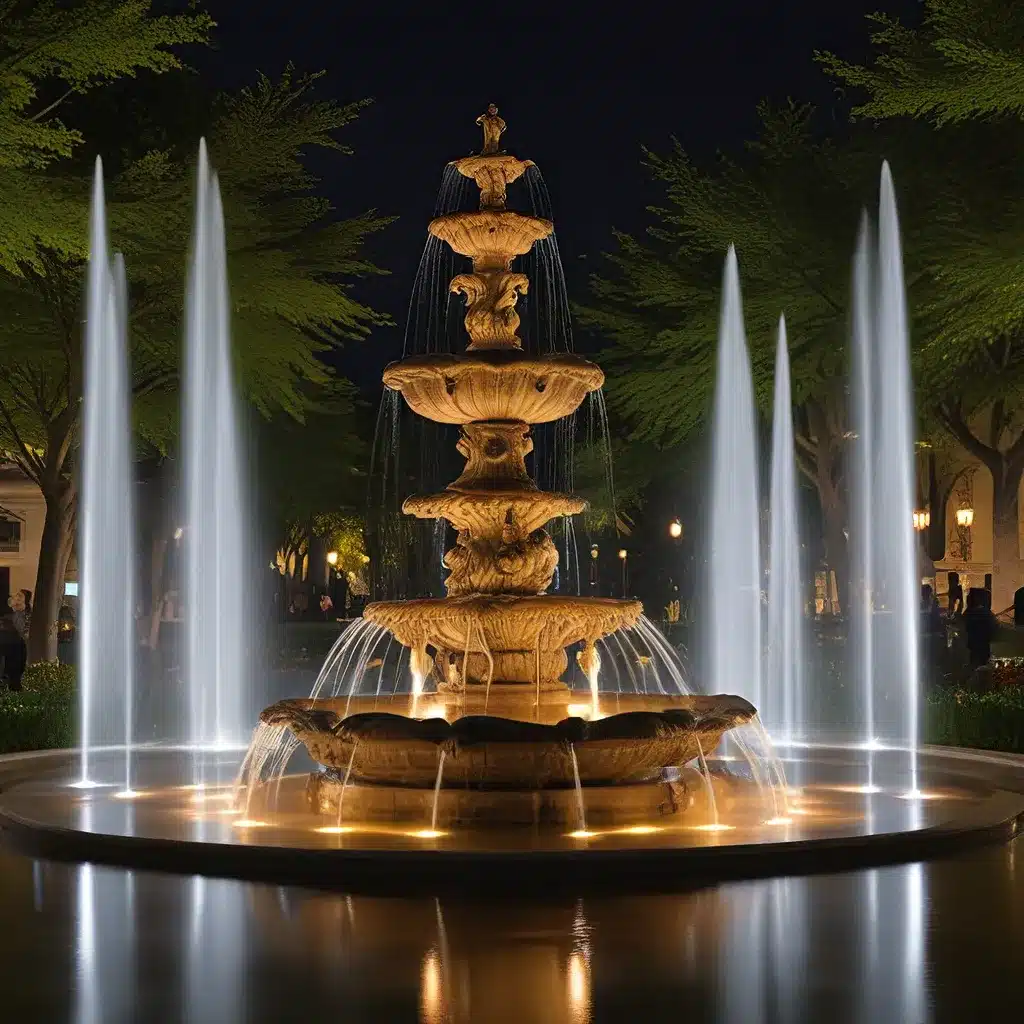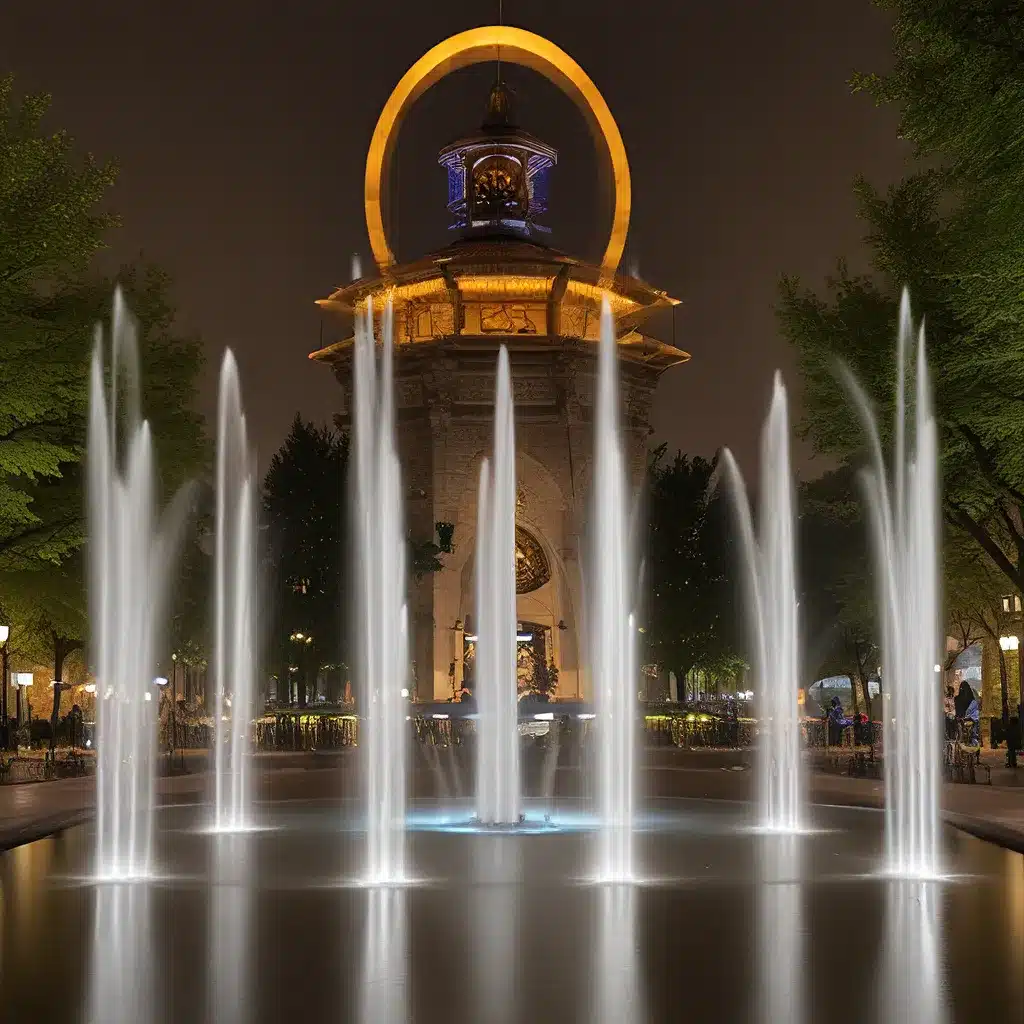
Fountain Design Essentials – Welcome to Fountain Lights
Fountain Design Essentials – Welcome to Fountain Lights

Ah, the mesmerizing dance of water and light – a sight that has captivated audiences for centuries. As a self-proclaimed fountain enthusiast, I’ve always been fascinated by the intricate hydraulic systems that bring these enchanting displays to life. And let me tell you, the world of fountain hydraulics is evolving in ways that are nothing short of awe-inspiring.
Fountain hydraulics is an intricate and captivating field that combines the principles of engineering physics and the pursuit of aesthetic beauty. It’s all about understanding how water moves, how it can be controlled, and how we can harness its natural elegance to create spellbinding water displays.
At the heart of this art form lies the delicate balance between hydrostatics (the study of fluids at rest) and hydrodynamics (the study of fluids in motion). It’s the interplay between gravity and pressure that allows fountain designers to manipulate water in ways that defy logic and leave onlookers spellbound.
Imagine a towering fountain, its water columns seemingly defying the pull of gravity, reaching for the sky in a captivating dance. Or a serene, mirror-like surface, reflecting the world around it with mesmerizing clarity. These feats of hydraulic engineering are the result of a deep understanding of the principles that govern fluid behavior.
The unsung heroes of fountain hydraulics are the pumps – the vital components responsible for moving the water and bringing these displays to life. From the quiet, unassuming submersible pumps perfect for smaller fountains to the powerful, external pumps that drive large-scale, grand-scale displays, each type plays a crucial role in shaping the overall experience.
The choice of pump depends on factors like the fountain’s size, the desired height of water projection, and the complexity of the water patterns. Submersible pumps, for instance, are ideal for more intimate settings, as they are quiet and easy to install. External pumps, on the other hand, are the workhorses of the fountain world, capable of powering the most ambitious and awe-inspiring water shows.
But the pump is just the beginning. The pipes and channels that transport the water from the source to the display elements are equally important. The material and design of these components directly impact the efficiency of water flow and the longevity of the system. From PVC and plastic for smaller, simpler designs to copper and stainless steel for larger, more elaborate fountains, the choice of materials is a crucial consideration.
As the water reaches the final stage of its journey, the nozzles and jets take center stage, playing a pivotal role in shaping the visual effects of the fountain. These unassuming elements are where the water meets the air, creating a visual feast that captivates the senses.
Different nozzle types can produce a wide range of effects, from a gentle, mist-like spray to a powerful, towering jet. The design and positioning of these nozzles are central to the aesthetic appeal of the fountain, allowing for the creation of intricate patterns and designs that leave onlookers mesmerized.
It’s a true choreographic masterpiece, where the designer must understand the dynamics of water flow – the difference between laminar flow (smooth and orderly) and turbulent flow (chaotic and irregular) – to craft the desired visual experience. By manipulating these flow types, they can create a symphony of water, light, and movement that resonates with the viewer on a profound, emotional level.
One of the primary challenges in fountain hydraulics is striking the perfect balance between aesthetic goals and engineering realities. Designers must consider a multitude of factors, from water distribution and wind interference to maintenance needs, all while creating visually stunning and technically proficient water displays.
It’s a delicate dance, where the principles of Bernoulli’s Principle (the relationship between velocity and pressure) and Pascal’s Law (the transmission of pressure in a confined fluid) must be carefully applied to achieve the desired effects. The hydraulic systems in fountains are a testament to human ingenuity, as we strive to harness the power and beauty of water in ways that captivate and inspire.
As the world becomes increasingly conscious of our environmental footprint, the fountain industry has embraced the call for sustainability. Recirculating water systems are now the norm, minimizing water waste and loss, while innovations in energy-efficient pumps and environmentally friendly materials are paving the way for a greener future.
The integration of smart technologies and automation is also transforming the landscape of fountain design. Sensors and computer-controlled systems are optimizing water usage and choreography, while the incorporation of renewable energy sources to power the hydraulic systems is further enhancing the sustainability of these mesmerizing displays.
As I ponder the future of fountain hydraulics, I can’t help but feel a sense of excitement and wonder. The continuous evolution of this field, driven by the integration of cutting-edge technologies and a renewed focus on sustainability, is leading to even more spectacular and environmentally friendly water displays.
The historical masterpieces, like the iconic Trevi Fountain, have paved the way for modern wonders, such as the Bellagio Fountains and the Dubai Fountains. And as we look ahead, the possibilities are truly limitless.
I can envision a future where fountains are not merely static displays, but dynamic, interactive experiences that respond to the presence and movements of the audience. Imagine a fountain that can “dance” to music, or one that can project captivating light shows synchronized with the ebb and flow of the water. The integration of augmented reality and projected mapping technologies could take the art of fountain design to unprecedented levels, blurring the lines between reality and imagination.
The journey of fountain hydraulics is an ongoing one, filled with endless possibilities and limitless potential. As we continue to push the boundaries of what’s possible, I can’t help but feel a sense of wonder and excitement for the future of these captivating water displays. So, the next time you find yourself mesmerized by a stunning fountain, take a moment to appreciate the intricate web of science, engineering, and artistry that lies beneath the surface. It’s a true masterclass in the art of manipulating one of nature’s most versatile elements – water.
Share to :
Subscribe to our newsletter for the latest in fountain design, innovative lighting ideas, and exclusive tips straight to your inbox. Join the community shaping the future of water features.

Rapid delivery to your doorstep.

Excellence in every product.

Great value for your investment.

Assistance at any hour.
Fountain Lights — Illuminating creativity in every splash!
Copyright © 2023. All Right Reserved